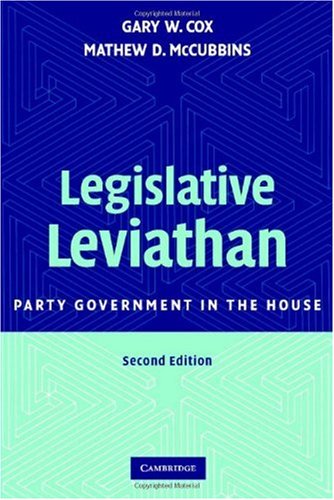Gary W. Cox, Mathew D. McCubbins9780511279225, 9780521872331, 0521872332
Table of contents :
Cover……Page 1
Half-title……Page 3
Title……Page 5
Copyright……Page 6
Contents……Page 7
Introduction……Page 21
1 The Weakness of Parties……Page 22
1.1 The Limited Role of Parties……Page 24
1.2 Rational Choice Views of Party……Page 25
1.3 The Theoretical Status of Parties……Page 26
1.4 Plus Ca Change………Page 28
2.1 The Decision-Making Power of Committees……Page 29
2.2 The Distinctiveness of Committees……Page 31
2.4 Summary……Page 32
3 An Outline of the Book……Page 33
Part One The Autonomy and Distinctiveness……Page 35
1
Self-Selection and the Subgovernment Thesis……Page 37
1 Self-selection……Page 39
2 Constituency interests and assignment requests……Page 41
3 Accommodation of assignment requests……Page 45
4 Accommodation of transfer requests……Page 52
5 The routinization of the assignment process……Page 57
6 What of norms in the assignment process?……Page 59
7 Whither assignment routines? the republican revolution……Page 60
8 Summary……Page 61
2 The Seniority System in Congress……Page 63
1 Seniority in the rayburn house: the standard view……Page 64
2 Reconsidering the standard view……Page 65
3 The empirical evidence……Page 67
4 Interpreting the evidence: postwar democratic rule……Page 72
5 Interpreting the evidence: the republican revolution……Page 75
6 Conclusion……Page 76
3 Subgovernments and the Representativeness of Committees……Page 78
1 The previous literature……Page 79
2 Data and methodology……Page 85
3 Results……Page 88
4 The representativeness thesis……Page 92
5 Conclusion……Page 94
Part Two A Theory of Organization……Page 97
4 Institutions as Solutions to Collective Dilemmas……Page 99
1.1 Standardization……Page 100
1.2 The Prisoner’s Dilemma……Page 102
2.1 Political Entrepreneurs……Page 104
2.2 Economic Entrepreneurs……Page 105
2.4 Central Agents……Page 106
3 Why central authority is sometimes necessary……Page 107
4 Multiperiod considerations……Page 112
5 Problems with central authority……Page 114
6 Conclusion……Page 117
5 A Theory of Legislative Parties……Page 119
1 The reelection goal……Page 120
1.1 The Party Record……Page 121
1.2 The Existence of Partisan Electoral Tides……Page 124
1.3 Secular Trends and Regional Differences……Page 127
1.4 The Perception of Partisan Electoral Tides……Page 129
1.5 Some Crucial Premises……Page 131
2 Reelection maximizers and electoral inefficiencies……Page 132
3 Party leadership……Page 135
4 Some criticisms of our theory and our rejoinder……Page 143
5 Conclusion……Page 144
Part Three Parties as Floor-Voting Coalitions……Page 147
6 On the Decline of Party Voting in Congress……Page 149
1 Party voting: trends since 1980……Page 150
2 Party voting: trends from 1910 to the 1970s……Page 151
2.1 Party Votes……Page 152
2.2 Intraparty Cohesion……Page 154
3 Party agendas and party leadership votes……Page 155
3.1 Party Agendas……Page 157
3.2 Party Leadership Votes……Page 161
3.3 Following the Leader: Party Voting Since the Republican Revolution……Page 165
4 Conclusion……Page 166
Part Four Parties as Procedural Coalitions: Committee Appointments……Page 169
7 Party Loyalty and Committee Assignments……Page 173
1 Assignments to control committees……Page 174
2 Party loyalty and transfers to house committees……Page 175
2.1 Previous Research……Page 176
2.2 Who Transfers?……Page 177
2.3 Data and Methods……Page 178
2.4.1 Democratic Transfers……Page 182
2.4.2 Republican Transfers……Page 184
2.5 Democratic Assignment Requests and Transfers……Page 185
2.6 Democratic Request Success and Failure……Page 187
3 Loyalty, the republican revolution, and the great purge of 1995……Page 190
4 Assignment success of freshmen……Page 191
5 Conclusion……Page 194
8 Contingents and Parties……Page 196
1 A model of partisan selection……Page 197
2 Which committees’ contingents will be representative?……Page 198
2.1 The External Effects of House Committee Decisions……Page 199
2.1.1 Committees with Uniform Externalities……Page 200
2.1.2 Committees with Targeted Externalities……Page 201
2.1.3 Committees with Mixed Externalities……Page 202
2.1.4 Summary……Page 204
2.2 Extramural Effects……Page 206
2.3 The Impact of Assignment Norms and Internal Party Practices……Page 207
3 Results……Page 208
3.1 Contingent Versus Party Means: ADA Scores……Page 209
3.2 Contingent Versus Party Medians: NOMINATE Scores……Page 213
3.3 Contingent Versus Party Distributions: NOMINATE Scores……Page 217
3.4 Contingent Versus Party Behavior on Committee-Related Roll Calls……Page 221
3.6 A Key Comparative Statics Test: Continuing Members
and New Members……Page 225
4 Conclusion……Page 228
Part Five Parties as Procedural Coalitions: The Scheduling Power……Page 231
9 The Majority Party and the Legislative Agenda……Page 233
1 The speaker’s collective scheduling problem……Page 235
2 Limits on the scheduling power……Page 237
2.1 Challengeable Scheduling Decisions……Page 238
2.2 Sharing the Scheduling Power……Page 240
3 Committee agendas and the speaker……Page 241
3.1 When Time Is Ample……Page 243
3.2 When Time Is Scarce……Page 245
4.1 Constructing Complex Logrolls……Page 247
4.2 The Majority Party’s Leaders as Deal Brokers……Page 248
5 Coalitional stability……Page 250
6 Critiques and rejoinders……Page 252
7 Conclusion……Page 253
10 Controlling the Legislative Agenda……Page 255
1.1.1 Creating and Destroying Subunits……Page 256
1.1.2 Assigning Tasks and Resources……Page 257
1.1.3 Regulating Subunit Personnel……Page 259
1.2 Can the Majority Party Act?……Page 260
2 The consequences of structural power: the legislative agenda……Page 261
2.1 Sponsorship and Committee Reports……Page 262
2.2 Deference to Committee Proposals……Page 264
3 The consequences of structural power: public policy……Page 270
4 Comments on the postwar house……Page 271
Conclusion……Page 275
Appendix 1: Uncompensated Seniority Violations, Eightieth through Hundredth Congresses……Page 279
Appendix 2: A Model of the Speaker’s Scheduling Preferences……Page 283
1.2 Some Implications of Optimal Scheduling……Page 285
Appendix 3: Unchallengeable and Challengeable Vetoes……Page 287
Appendix 4: The Scheduling Power……Page 289
Bibliography……Page 295
Author Index……Page 315
Subject Index……Page 319

Reviews
There are no reviews yet.